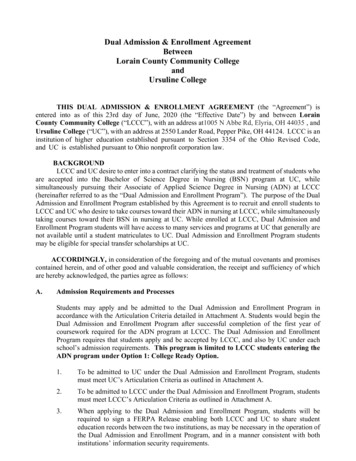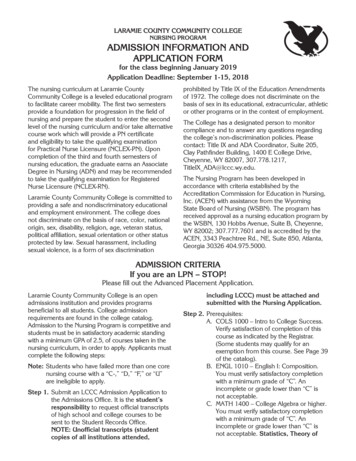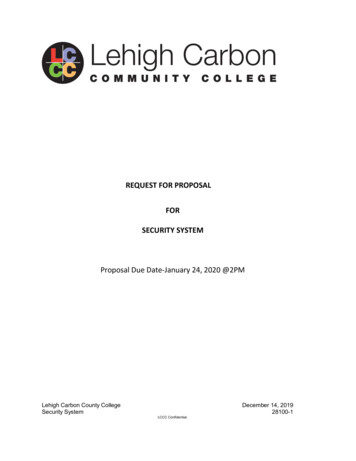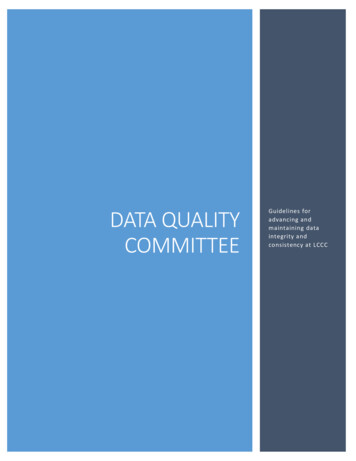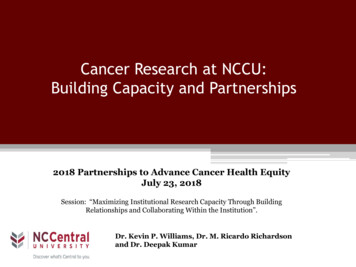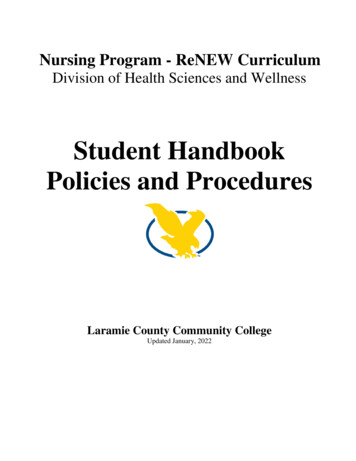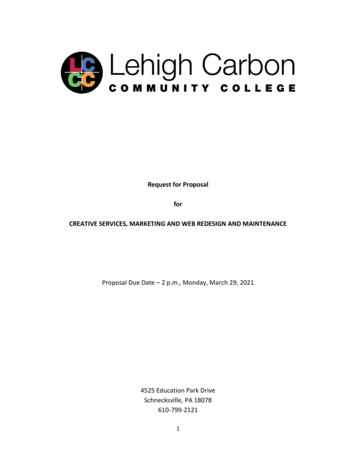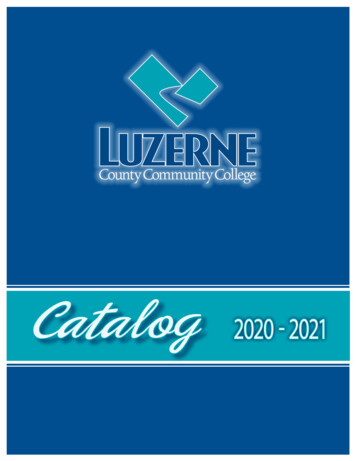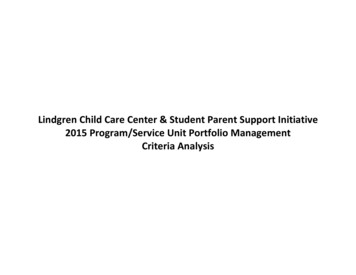
Transcription
Lindgren Child Care Center & Student Parent Support Initiative2015 Program/Service Unit Portfolio ManagementCriteria Analysis
Lindgren Child Care Center & Student Parent Support Initiative2015 Program/Service Unit Portfolio ManagementCriteria Analysis:Demand Criteria:1. Program Essentiality and Potential (250 words)1.1. What are the functions and/or services that your unit provides and to which constituencies/clients and the costs of providing these programs andservices? Complete table using functional categories supplied or include additional categories if needed:1.2. Program uniqueness to SCSU, state and region, such as: Legislative, regulatory or other requirements Unique impact on the university, our students and region Impact on the diversity of our campus and community Other benefits to SCSU by offering this program/service1.3. Reliance or interdependency of program/service with other programs/services. For example, What are the relationships/interdependencies of your program with other programs and/or other university services? Are there opportunities for interdisciplinary programming, shared programming or resources or collaboration with other programs in the futureThe Lindgren Child Care Center (LCCC) provides; Nationally Accredited care to children (2 months to 5 years) of student parents, inclusive support for studentparents, laboratory placements to SCSU practicum students from at least six academic departments each semester, leadership and professional developmentto student employees, and programing through the Student Parent Support Initiative (SPSI-grant funded) aimed at supporting SCSU student parents fromenrollment through graduation.LCCC is; accredited and regulated by the National Association for the Education for Young Children (NAEYC),licensed and regulated by the MN Department of Human Services,regulated by the Federal Food Program; Child and Adult Care Food Program (CACFP),rated and regulated by Parent Aware: Minnesota’s Quality Rating and Improvement System.licensed by the City of St. Cloud Health and Inspection DepartmentLCCC and SPSI are unique, as they are the only programs on campus whose main function is dedicated to the underserved student parent population, (7% oftotal SCSU population). Due to changing demographics, a culture shift in institutional thinking must take place; we must create a place that is family friendly forstudents and faculty alike.1 LCCC and SPSI are leading this movement, proof of their importance as a recruiting mechanism lies in communication from parents1WHITE, G. (2014, December 11). The Quiet Struggle of College Students With Kids. The Atlantic.
stating they will not enroll at SCSU unless their child is admitted to LCCC. Current parents also express satisfaction via survey and informal email stating “I wouldnot be at SCSU if LCCC did not exist”.The LCCC collaborates with; Multiple campus departments to create a diverse workforce. Center for International Studies in offering an on-campus cross cultural component for international students, a requirement for someprograms. Academic departments to create practical learning experiences and service learning for students;o CPSY (ABA), NURS, CFS, SW, SPED, CSD, GLSTAfter graduation, professionals must be able to communicate effectively with other fields. In quality, professionalism, and proximity the LCCC is the perfect hostfor interdisciplinary experiences for any of the helping professions. LCCC is an on-campus site where this interdisciplinary experience should take place.2. Demand – Current and Future (250 words)2.1. What demand trends do you expect for your services in the next five years?2.2. What opportunities exist for your program/service to adapt to meet future student and university needs and demands?2.3. What opportunities are you pursuing/could you pursue to alter program/service delivery to meet new needs?National Trends Student Parents have increased by 1.6 million since 1995 with more than half of this number coming since 2007. 2 Currently 22% of adult population has some college credit but no degree, in order to meet the goals of the Obama administration along with LuminaFoundation’s goal of having 60% of the adult population with a postsecondary credential by 2025, serving this population is clearly necessary. 3 Research states having an on campus child care center is imperative as; there is a direct correlation between the success of student parents in higher education and the availability of quality child care, and 4 research states 95% of student parents report having access to child care was crucial in their decision to increase credit load 5Minnesota Trends To maintain economic growth, Minnesota must improve retention for three key groups; lower- income students, students of color, and low-wageworking adults. Included in best practices to achieve this growth includes on-campus child care. 6 Current demographics of LCCC families are consistent with these data points;o 30% rise in the number of student families served from FY2010-2014o low income students, 60% of the children using the child care center qualify for free school lunch and 94% of undergraduate student parents arePell eligibleo student families of color in the center ranges 25-35%, compared to 22.2% in the general student body.72Campus Child Care Declining Even As Growing Numbers of Parents Attend College. (2014). Institute for Women's Policy Research, IWPR #C425.Soares, L. (2013). Post-traditional Learners and the Transformation of Postsecondary Education: A Manifesto for College Leaders.4 Mosee, Sherill. Promoting Student Parent Success in Higher Education. Higher Education Alliance of Advocates for Students with Children, 2012. Web. 24 Feb. 2015.5 Child Care at College Campuses: A Critical Resource for Student Parents. Institute for Women’s Policy Research, 2015. Web. 24 Feb. 20156 A Discussion of Retention and Completion. (2015). Minnesota Office of Higher Education,29.7 2014 30th Day Enrollment Profile. (2014, October 7). Retrieved February 24, 2015, from s/Fall2014TotalEnrollmentProfile.pdf3
We believe that, as SCSU colleges and departments ramp-up to provide more evening and especially weekend programs that enable the working adult topursue additional higher education, LCCC can effectively assist those adult students, traditionally underserved students by providing child care on campusduring those non-traditional hours and days.Strength Criteria:3. Strategic Alignment – (500 words)3.1. How does your unit align with the SCSU’s mission and strategic plan? How does your program engage in the issues and opportunities that face the communities we serve? Describe your efforts to embed sustainability in your programs, services and practices? How does your program participate in the world community through internationalized activities? How does your program support active learning strategies for students?3.2. How does your program align with your major unit’s strategic plan/outcomes/action plans?3.3. What opportunities are there for better alignment in the future?As a place where theory is put into practice, Lindgren Child Care Center is a training and laboratory resource to the entire campus, and a model of excellence forthe community of St. Cloud.Not only does LCCC serve as a “best practice” lab placement site, but it is also a model for the child care community. The director is a master trainer throughthe MN Center for Professional Development, and routinely trains the local Early Childhood Community, all Professional staff are routinely invited to presentat external conferences, along with presenting at our own Annual Early Childhood (EC) Conference designed to bring relevant and challenging workshops tothe local EC community. Also, the Greater St. Cloud Area continues to address shortages in early childhood mental health services through a professionallearning community called THRIVE. Three LCCC professional staff are integral members of these efforts.The LCCC is a true program of sustainability as we provide education and investment in two generations of learners. Studies show children with parents thathave a degree are more likely to complete a degree themselves.8 Through the support of LCCC, countless children have or will become second generation collegestudents. For SCSU students who are the parents of the children in our care, we advise, support, educate, and refer; thereby supporting their wholedevelopment. Not only can we assist these student parents in their successful navigation to graduation, but we also validate and celebrate their vital roles asparents and the work associated with parenting. In addition, LCCC has been directly involved in the environmental sustainability movement for the past 8 yearsas the preschoolers hold an annual used book sale. This initiative began as a recycling project in 2007.LCCC serves as an on campus site for international students to engage in a cross cultural component, as it is often a requirement of their experience. Theseexperiences vary from volunteer work to complete involvement in the classroom experience which brings valuable cultural perspectives to our community.These students often move from a volunteer experience to an employee based on their interests.8Dubow, E. F., Boxer, P., & Huesmann, L. R. (2009). Long-term Effects of Parents’ Education on Children’s Educational and Occupational Success: Mediation by Family Interactions, Child Aggression, and TeenageAspirations.Merrill-Palmer Quarterly (Wayne State University. Press), 55(3), 224–249. doi:10.1353/mpq.0.0030
Academic departments and faculty clearly see the value of the student learning experience through student practicum assignments at Lindgren. Not only dothose practicum students come into the center and carry out an observation or practice, they are modeled and mentored by a lead professional teacher in thateffort, who then provides reflective consultation with them after their experience. In an email conversation with a faculty member it was stated, “while it isimportant for all students to have varied experiences, as a placement site LCCC was described to be the “crème de l ’crème” of placement sites.” As of2/18/15, over 900 hours of internship and practicum experiences have already been scheduled for Spring 2015, included in this number are 12 credits (3undergraduate, 9 graduate) of internship experience spent exclusively at LCCC.In accordance with our philosophy, LCCC offers a comprehensive training program that gives each teaching staff member the opportunity to learn, develop, andpractice in a high quality early care and education facility. This Five-Part Staff Development Strategy incorporates modeling, mentoring, evaluation, andprofessional development that include training that leads to a Child Development Associate (CDA) credential at no cost to our employees.All student parents are encouraged to connect with SPSI support programming which provides free educational workshops, weekly support groups, on and offcampus referrals and support, and social connections to other student parents.As described above, LCCC’s Professional Development Plan is an excellent example of co-curricular activity. Data that comes out of this plan include; 88% of student employees report communication, leadership, or teamwork in a diverse environment as key skills learned during employment atLCCC 96.3% of student staff report their work gives themselves a feeling of personal accomplishment Credit taking behavior of current employees outpaces former employees by 1.13 (13.65/12.52) credits per student4. Student Experience and Campus Community Success (250 words)4.1. How does your program/service support student success and/or the campus community?4.2. What steps have you taken to enhance service and support to underserved populations (as defined by your unit)?Access to higher education is of utmost importance to traditionally underserved populations, and demographically colleges and universities must recruitstudents, described above, who are first-generation, low-income, or minority. However those students must not only get in to college but must also cross thefinish line. When tracking student parent user’s Fall 2011 to Fall 2014 persistence, of parents that did not graduate, 90% of students continue to persist. Duringthe same three year period 31% of LCCC users completed their degrees. This compares favorably to research that shows only 33% of student parents completetheir degree in six years of enrollment.9 This persistence and graduation rate clearly indicates that these student parents, when using LCCC, achieve success byfinishing their degrees. This clearly demonstrates LCCC’s direct contribution to the success of this underrepresented population.Services at LCCC are enhanced by creating a multicultural environment. Because many of our children are from culturally diverse backgrounds, it is importantthat they experience a similarly diverse staff at Lindgren. LCCC employs 40-50 students who begin their relationship with LCCC from one of a number ofunderrepresented populations including work-study (state and federal), cultural diversity funds (grants supportive of hiring student employees that reflect thecultural and ethnic background of our student families), and through a collaboration with MSS utilizing students that qualify for Access and Opportunity (A &9Gault, Barbara, Ph. D., et al. 4.8 Million College Students are Raising Children. Institute for Women’s Policy Research. November 2014
O) benefits.As of Fall 2014, 50% of our student employees are students of color, up from 14% only five years ago. Fall to Fall persistence of our current studentemployees during the past three years ranges from 85%-92%. This validates the work that is put into the staff development plan and putting together adiverse work environment.5. Quality and Continuous Improvement as Evidenced through Assessment and Evaluation (250 words)5.1. Describe the status of the assessment or evaluation efforts of your program/service. How do you measure success and performance?5.2. What changes have you made to your program/service in the last two years based on evaluation results?Maintaining our National Accreditation through the National Association of Young Children (NAEYC) is the greatest example of how LCCC utilizes best practices inour work. In 2014, LCCC successfully completed the Re-Accreditation process, receiving commendations in 7 out of the 10 standard areas includingRelationships, Assessment, Health, Teachers, Families, Community relationships, and Leadership and Management. The accreditation process is rigorous andincludes an extensive self-study to measure program and services.Assessments completed during this process include; NAEYC Teaching Staff Survey NAEYC Family Survey Program Administration Scale (PAS)* Early Childhood Environment Rating Scale (ECERS)* Infant Toddler Environment Rating Scale (ITERS)* ISRS is used to follow persistence and graduation rates of both student parent and employee populations along with track total number of users In addition to the above assessments designed to aid in Accreditation Self-Assessment, LCCC also implements a yearly Student Staff SatisfactionSurvey and Student Parent Satisfaction Survey.* valid and reliable instruments designed to measure the leadership, management practices, and environments of early childhood programs.LCCC measures success by: Maintaining NAEYC Accreditation Parent & Staff satisfaction of LCCC experience Graduation and persistence of student parents Graduation and persistence of student staff Growth in number of users Meeting yearly revenue target (FY 2015 270,000)In a Spring 2014 Parent Satisfaction survey, low satisfaction rates were reported around parents’ ability to interact with other parents. It is imperative to thestudent parent’s success that they have an opportunity to meet and interact with other likeminded individuals. 10 To increase the interactions LCCC has10Child Care at College Campuses: A Critical resource for Student Parents. Institute for Women’s Policy Research, 2015. Web. 24 Feb. 2015
increased its collaboration with the SPSI to create programing specifically designed for student parent social interactions including “Stay and Play” sessionswhere LCCC is open to the entire SCSU student parent community as a safe, inviting location to bring the family and interact with other student parents.In a Spring 2014 Student Staff Satisfaction survey, low satisfaction rates were reported around perceived co-worker morale, co-worker professionalism. Afocus group of current student employees was convened, it was determined that changes to Fall Staff Orientation could alleviate some of this distress.During Fall 2014 Student Orientation individual training pinpointed at the morale/professionalism of LCCC student employees included “Integrity” and “Howto Be A Successful LCCC Employee”.Cost, Productivity and Resources6. Cost and Productivity (250 words)6.1. What could you do differently to improve the effectiveness of your program/service but have not had the opportunity, time or resources to do?6.2. What strategies do you suggest for reducing costs in your unit or make your unit more efficient?6.3. What are the opportunities for new revenue from your services and programs?LCCC is in the process of completing a comprehensive needs analysis that will survey all SCSU student parents to determine if current hours/days of operationare meeting the needs of the diverse student parent population. Student parents must balance the stressors of employment, university coursework, and familyresponsibilities. As the university becomes more flexible for adult learners, LCCC intends on meeting the student parent child care needs to prevent the lack ofhigh quality child care from being a barrier to persistence. These efforts could also be enhanced through staffing collaborations with the SPSI.Through fundraising and grants, the LCCC has augmented its 0999 object code 5,000 during FY 2015. This is particularly important as LCCC’s object code 0999was reduced over 1,000 during the 2015 fiscal year. These funds have been designated to enhance the outdoor playground space with the purchase of theOutlast Play Equipment though Community Playthings. This fundraising and grant writing directly impacts the quality of the physical space and environment ofLCCC.As a site for practical learning we are collaborating with academic departments, and welcome any new collaboration, to create experiences that require studentsto apply pedagogical knowledge in a real life situation. These experiences are often a win-win, as students receive a quality experience , and LCCC receivesadditional classroom supports.As of August 1, 2014 the LCCC was already at capacity for Fall 2014; after this point 25 student families inquired about enrolling their child/children and were puton a waiting list. Similar numbers were seen prior to Spring 2015. During the past three academic years (with the exception for Summer Session), LCCC has beenat capacity with a waiting list. With the rising number of student families it would be in the best interest of SCSU to explore the possibility of expanding its childcare services to the student parent population.During the next possible period LCCC will apply for a federal grant, Child Care Access Means Parents in School Program (CCAMPUS), aimed at campus child carecenters. Funds are used to support the needs of low-income student parents, i.e. tuition reimbursement.
7. Adequacy of Current Resources (250 words)7.1. Are current resources (FY15 levels) adequate to support the program (finances, faculty and staff, program administration, physical facilities, equipment,etc.)?The LCCC depends on an excellent professional and student staff to deliver high quality services to student families. During the past two fiscal years LCCC’sstudent employment allocation has been decreased by 19%. This budget reduction puts a strain on LCCC’s ability to meet the needs of our student families aswe are required by our licensing agency (MN DHS) and our accrediting body (NAEYC) to maintain a consistent and rich ratio of staff to children. During thestudent employment downturn in 2014, two professional employees left for other opportunities, anecdotally citing student staff reductions weighing into theirdecision. While this strain has not yet shown itself in terms of our revenue generation, staff satisfaction and turnover will continue to be a concern in the futureif more reductions are made.The LCCC is dedicated to meeting the child care needs of SCSU Student Parents. In order to ensure the ability to maintain service and have the opportunity toexpand service, FAC has received a proposal to keep the LCCC associate director position vacant, in return to increase student employment hours to same levelas FY 2014. This proposal reflects a savings of 53,111 for FAC.
Foundation's goal of having 60% of the adult population with a postsecondary credential by 2025, serving this population is clearly necessary. . How does your unit align with the SSU's mission and strategic plan? . LCCC offers a comprehensive training program that gives each teaching staff member the opportunity to learn, develop, and .
